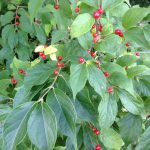Asiatic Honeysuckles
Identification:
There are multiple types of invasive Asian bush honeysuckles. All non-native varieties have hollow stems and twigs, and may grow up to 17 feet tall. The opposite leaves are long and ovate in shape.
There are many minor differences between the species of invasive honeysuckle. The Amur Honeysuckle has oblong leaves that taper to a small point; the flowers can be white to pale pink. The Tartarian honeysuckle leaves are smooth on the underside. The flowers of Morrows are generally white, while Bella’s flowers are usually pink. All honeysuckle bushes flower in late May to June and this is followed by round red fruit in pairs that ripen mid to late summer on the stem. The easiest identification feature for these plants is their bright red berries.
These plants form large dense stands that outcompete native plant species. They alter habitats by decreasing light availability, depleting soil moisture and nutrients, and possibly by releasing toxic chemicals that prevent other plant species from growing in the vicinity. They may also compete with many native species for pollination among local insects.
Control:
Hand removal of plants is possible for light infestations and where native species co-occur with it. When the soil is moist, firmly grasp the plant low and tug gently until the main root loosens from the soil and the entire plant pulls out. Remove the plant with its entire root system or new plants may sprout from root fragments. Take care not spread any plants that have gone to seed. Remove completely from the site and dispose of in garbage bags.



